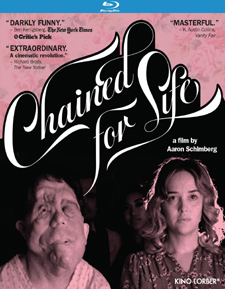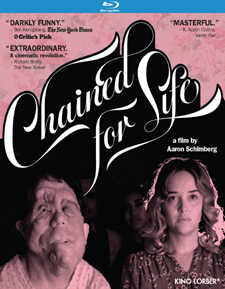Chained for Life (Blu-ray Review)

Director
Aaron SchimbergRelease Date(s)
2019 (January 7, 2020)Studio(s)
Flies Collective/Grand Motel Films/The Eyeslicer (Kino Lorber)- Film/Program Grade: B
- Video Grade: A-
- Audio Grade: A
- Extras Grade: C
Review
Chained for Life, which shares its title with a 1952 film about conjoined twins, is a movie about the making of a movie—a horror flick directed by a European wunderkind known only as Herr Director (Charlie Korsmo). The cast and crew gather at a former hospital to shoot this low-budget thriller.
Herr Director has managed to hire up-and-coming actress Mabel Fairchild (Jess Weixler, Teeth). The plot centers on a German cosmetic surgeon who performs highly questionable procedures and a hospital full of people with physical aberrations, including a very tall man, a woman with severe burns, a pair of conjoined twins, a dwarf, and Rosenthal (Adam Pearson, Under the Skin), a man with neurofibromatosis, the same condition that afflicted Joseph Merrick, otherwise known as the Elephant Man.
The film starts slowly as the cast and crew gather, going through the routines of moving equipment, greeting each other, and checking out their accommodations. Once the film hits its stride, we seesaw between scenes of the crew working behind the camera and of the movie being shot. Sometimes director Aaron Schimberg takes us into long dream sequences. Other times we think the actors are just talking among themselves only to learn that we’ve been watching a scene being shot. The result causes a combination of fascination and confusion as Schimberg keeps us guessing until the jarring revelation.
The film is reminiscent of earlier movies in which physical disfigurement is the focus—Freaks, Mask, The Man Without a Face, and the silent melodrama The Man Who Laughs come to mind. Schimberg, however, doesn’t use these physical differences to terrify. As we watch the tedious process of moviemaking, Mabel, whose character is supposed to become romantically involved with Rosenthal’s, gets to know him as a friend and co-worker. She and the other “normal” people mingle with the extras with disabilities. The film has an undercurrent of dark humor, but never at the expense of its human oddities.
In Freaks, director Tod Browning spends the first half of the film showing performers in a traveling circus as regular folk with unusual appearances and abilities. It’s the so-called normal people who are the true monsters. Chained for Life devotes considerable screen time to Rosenthal, who is a real character and not a mere representation. Though it offers a few tropes of the horror genre, Chained for Life is a sensitive film that emphasizes similarities rather than differences, between people of normal appearance and those who bear physical disfigurement.
A prologue quotes critic Pauline Kael’s statement that actors and actresses tend to be more beautiful than the rest of us because people enjoy looking at pretty things, including and especially other people.
Casting Pearson as Rosenthal is what distinguishes Chained for Life. He has a significant role, several lengthy scenes with a lot of dialogue, and he is a good actor despite being hampered by a face that doesn’t permit much range of expression. He delivers his lines naturally and conversationally, and is quite emotionally effective. Initially, his appearance is what we focus on, but Schimberg treats Rosenthal without fanfare. He arrives in a bus with the other extras and blends in, with most of his early scenes filmed in long shot. By the time we see him in close-up, his appearance is not a shock.
Schimberg provides a compassionate look at Rosenthal, the most dramatically disfigured among the cast. The film feels like a cross between artful indie and cult flick with its blend of an unusual screenplay, offbeat casting, and a flair for audience manipulation. The running time is only 91 minutes, but a few cuts could have been made to pep up the pace.
The Blu-ray release from Kino Lorber, featuring 1080p resolution, is presented in an aspect ratio of 1.85:1. Director of photography Adam J. Minnick employs conventional lighting as the crew are first seen scurrying about with equipment and greeting one another before the “freaks” arrive. Later, in an exterior scene in which Mabel and Rosenthal discuss acting, natural light and reflectors are used to enhance the sunny weather. The scenes of the film-within-the-film have more atmospheric lighting, with deep shadows, but director Schimberg plays with viewers, sometimes making us think we’re watching the filmmakers at work, then surprising us with a shout of “Cut!” or a camera pan revealing the film crew watching the scene we just thought was real, not scripted. A sequence in which Herr Director asks Rosenthal to emerge from darkness delivering his lines at different points is shown repeatedly, accentuating the repetitiveness of the moviemaking process. A campfire scene is shot with an entirely black background, so there’s no visual reference to what the location is. Schimberg favors long, uninterrupted takes. The scene of Mabel being driven to the airport is one single shot of Mabel sitting and talking to the driver from the backseat of the car. Schimberg and Minnick don’t use extreme camera angles or elaborate set-ups in order to keep the look of the film simple.
The soundtrack is English 2.0 DTS-High Definition Master Audio. An alternate track features English 5.1 DTS-High Definition Master Audio (with audio coming from the center channel only). Optional English subtitles are available for the hearing impaired. There are dramatic sound effects in the film-within-the-film scenes—glassware being smashed, a blood-curdling scream, surgical instruments clanking against each other, and voices echoing from the large hospital rooms. Dialogue is clear throughout, particularly from Adam Pearson, who speaks with a British accent. With his distorted face and our memories of the film The Elephant Man, the assumption is that Pearson’s tumors and distorted mouth will affect his speech, but he’s clear as a bell. His voice is pleasant, expressive, and reflects intelligence. There’s a realistic balance of dialogue with ambient sound when the crew is seen doing their jobs. There’s often a lot of activity behind actors shown in close-up or medium shot. C. Spencer Yeh’s score has a gentle eeriness and avoids cliché horror music with its loud, dissonant chords.
Bonus materials on this Unrated Blu-ray release include an audio commentary; interviews with actors Jess Weixler, Adam Pearson, and Sari Lennick; a deleted scene; and two trailers.
Audio Commentary – Director Aaron Schimberg, who opens the commentary by stating he’s recording it in the wee small hours of the morning, sounds tired and bored. His tone is unenthusiastic throughout. He wanted a slow opening, which he refers to as boring. Jess Weixler is unusually warm and made the character of Mabel, as written, more complex. The opening establishes the relationships among cast and crew. Though the film-within-the-film is shot digitally, Chained for Life was shot on Super 16mm film. In the first cut, there was more footage of the crew making the film, but it was out of order and would have been confusing, so deletions were made. Those who read the script didn’t like a specific section, but Schimberg kept the footage—not the best—because it held the film together and provided continuity. He attributes actor flubs to last-minute script changes. The severely burned woman, Diana Tenney, was found only a week prior to filming. Editing and the shifting of scenes shape the ultimate film. Often, the viewer doesn’t know what plane of reality the film is on. “At several points in the film, you might feel like you had the rug pulled out from under you.” In the final scene, Mabel’s car ride to the airport, featuring a long, uninterrupted close-up in the backseat, there is small talk between her and the unseen driver that initially produces tension. How scenes are shot affects the viewer’s perception. It took a full day to rig the camera inside the car and shoot. The driver is actually driving as he delivers his dialogue. Both actors totally nailed it and the first take is what is in the film. During the last shot of the disabled extras on the bus, Schimberg wanted a particular song to accompany the visual and, despite difficulty in securing the rights, he got his wish.
Interview with Adam Pearson – Director Aaron Schimberg saw him in the film Under the Skin and wanted him for the role of Rosenthal. Pearson read the script and liked it. He auditioned with the car and campfire scenes because both involved a lot of dialogue. Pearson notes, “As long as you know your lines, you’ll be alright.” He discusses the “many moving parts” of a performance, including being aware of where the camera is, the emotion required, relation to other actors, clearing the filming area, and matching shots. He speaks highly of how effective Schimberg is at his job. Schimberg was born with a cleft palate, so he empathizes with being disfigured. The director didn’t want to be “soap boxy,” but he wanted to pay homage to films he liked (Freaks, The Elephant Man). Pearson became friends with co-star Jess Weixler, who is a great actor and person.
Interview with Jess Weixler – Weixler says she has a disabled father (hemophilia) and his father had faced cancer. She had never seen physical disfigurement except in horror films. Chained for Life shows disfigured individuals as people. Adam Pearson told her he spends the first ten minutes of meeting new people making them comfortable. She had to find a way to connect that was not typical, since Pearson’s facial tumors made it difficult to read his expressions. She discusses actors of normal appearance, such as Eddie Redmayne and Daniel Day Lewis, playing disabled people and then winning awards. The film asks, “Should normal actors portray the disabled on screen?” She believes there’s no easy answer. Disabled people having sex is usually not portrayed on screen, but this is another way to normalize them. Schimberg did not want the film to be exploitative.
Interview with Sari Lennick – Lennick is the wife of Aaron Shimberg’s longtime friend. She learned from the script she was playing an actress playing a Russian nurse in the film-within-a-film. She knew Schimberg was obsessed with Tod Browning’s Freaks and always wanted to know what happened after that film ended. Chained for Life is an “intersection between Hollywood vanity and disfigurement.” Lennick loves playing ugly people. She shot some of her scenes in Brooklyn and then at the hospital in a small Pennsylvania town. The cast and crew became a very tight family. “Art imitating life happened quite a bit.” The life stories of the disfigured and disabled cast were gripping. Cast members preferred the term “disfigured” to “facially different” since all faces are different. The film was shot in long takes during long shooting days. Improvisation was used, Schimberg would tighten the dialogue and rehearse, and then shoot. Lennick grew up with an aunt who had neurofibromatosis, so she was already familiar with its effects.
Deleted Scene – The film crew, sitting at and standing around a table, discuss the script and the shooting schedule. Since there is similar content in the completed film, the scene was deemed redundant.
Trailers – Two trailers for the film are included: the lengthy theatrical trailer and the shorter teaser trailer.
– Dennis Seuling

